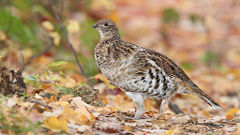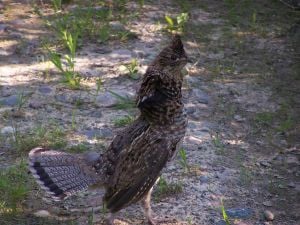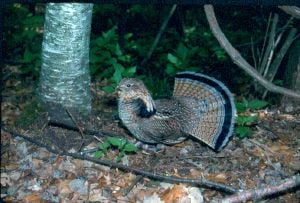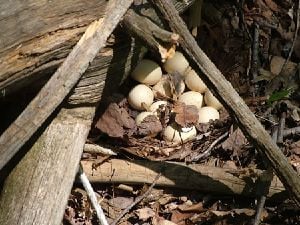Difference between revisions of "Ruffed grouse" - New World Encyclopedia
Rick Swarts (talk | contribs) |
Rick Swarts (talk | contribs) |
||
| Line 19: | Line 19: | ||
| binomial_authority = ([[Carolus Linnaeus|Linnaeus]], 1766) | | binomial_authority = ([[Carolus Linnaeus|Linnaeus]], 1766) | ||
}} | }} | ||
| − | '''Ruffed grouse''' is the common name for a medium-sized [[North America]]n [[grouse], '''''Bonasa umbellus''''', characterized by mottled gray-brown or red-brown plumage, feathered lower legs, erectile black feathers on the sides of the neck of the | + | '''Ruffed grouse''' is the common name for a medium-sized [[North America]]n [[grouse], '''''Bonasa umbellus''''', characterized by mottled gray-brown or red-brown plumage, feathered lower legs, erectile black feathers on the sides of the neck of the ruff (collar of prominent feathers), and a fan-shaped tail with a distinctive black band. The male ruffed grouse is known for loudly drumming its wings, sometimes on a fallen log, to attract females. It is [[bird migration|non-migratory]]. |
==Overview and description== | ==Overview and description== | ||
| Line 25: | Line 25: | ||
The ruffed grouse is one of about 20 species of [[grouse]], which are plump, chicken-like, terrestrial [[bird]]s comprising the family Tetraonidae of the order [[Galliformes]]. Grouse tend to be plump birds that have a protective coloration of mottled brown, gray, and red [[feather]]s, which cover the nostrils and partially or entirely cover the legs, with feathers to the toes. | The ruffed grouse is one of about 20 species of [[grouse]], which are plump, chicken-like, terrestrial [[bird]]s comprising the family Tetraonidae of the order [[Galliformes]]. Grouse tend to be plump birds that have a protective coloration of mottled brown, gray, and red [[feather]]s, which cover the nostrils and partially or entirely cover the legs, with feathers to the toes. | ||
| − | Ruffed grouse (''Bonasa umbellus'') have a cryptic plumage with mottled gray, brown, black, and buff coloration and two distinct color [[morph (zoology)|morph]]s, gray and brown (or red) (Rusch et al. 2000). These two color morphs are most distinctive in the tails, with the gray morph having gray tails, and the brown morph being rufous (reddish-brown or brownish-red). In the gray morph, the head, neck, and back are gray-brown; the breast is light with barring. There is much white on the underside and flanks, and overall the birds have a variegated appearance; the throat is often distinctly lighter. The tail is essentially the same brownish gray, with regular barring and a broad black band near the end ("subterminal"). Brown-morph birds have tails of the same pattern, with rufous tails and the rest of the plumage much browner, giving the appearance of a more uniform bird with less light plumage below and a conspicuously red-brown tail. There are all sorts of intergrades between the most typical morphs. The gray color morph is more common in northern parts of the range and the brown color morph in the more southern parts (Rusch et al. 2000; Grzimek et al. 2004). | + | Ruffed grouse (''Bonasa umbellus'') have a cryptic plumage with mottled gray, brown, black, and buff coloration and two distinct color [[morph (zoology)|morph]]s, gray and brown (or red) (Rusch et al. 2000). These two color morphs are most distinctive in the tails, with the gray morph having gray tails, and the brown morph being rufous (reddish-brown or brownish-red). In the gray morph, the head, neck, and back are gray-brown; the breast is light with barring. There is much white on the underside and flanks, and overall the birds have a variegated appearance; the throat is often distinctly lighter. The tail is essentially the same brownish gray, with regular barring and a broad black band near the end ("subterminal"). Brown-morph birds have tails of the same pattern, with rufous tails and the rest of the plumage much browner, giving the appearance of a more uniform bird with less light plumage below and a conspicuously red-brown tail. There are all sorts of intergrades between the most typical morphs. The gray color morph is more common in northern parts of the range and the brown color morph in the more southern parts (Rusch et al. 2000; Grzimek et al. 2004). All ruffed grouse except juveniles have the prominent dark band near the tip of the tail (Rusch et al. 2000). |
| − | |||
| + | Ruffed grouse have a tuft of feathers on the sides of the neck that can be erected into a ruff (Rusch et al. 2000). The ruff, which is a collar of prominent feathers, is on the sides of the neck in both sexes. Ruffed grouse also have a crest on top of their head, which sometimes lies flat. Both sexes are similarly marked and sized, making them difficult to tell apart, even in hand. The female often has a broken subterminal tail band, while males often have unbroken tail bands. Another fairly accurate sign is that rump feathers with a single white dot indicate a female; rump feathers with more than one white dot indicate a male. | ||
| + | The ruffed grouse is frequently referred to as the "partridge" or as a "birch partridge." This is technically wrong, as [[partridge]]s are unrelated [[Phasianidae|phasianids]] (family Phasianidae). In hunting, this may lead to confusion with the [[gray partridge]], a species that was introduced to North America from [[Europe]] and is a bird of open areas, not woodlands. | ||
| − | + | ==Distribution and habitat== | |
| − | |||
| − | |||
is a medium-sized [[grouse]] occurring in forests from the [[Appalachian Mountains]] across [[Canada]] to [[Alaska]]. It is [[bird migration|non-migratory]]. | is a medium-sized [[grouse]] occurring in forests from the [[Appalachian Mountains]] across [[Canada]] to [[Alaska]]. It is [[bird migration|non-migratory]]. | ||
The ruffed grouse (''Bonasa umbellus'') is known for drumming on a fallen log to attract females. | The ruffed grouse (''Bonasa umbellus'') is known for drumming on a fallen log to attract females. | ||
| − | |||
| − | |||
| − | |||
==Ecology== | ==Ecology== | ||
Revision as of 23:09, 19 December 2008
| Ruffed grouse | ||||||||||||||||||||
|---|---|---|---|---|---|---|---|---|---|---|---|---|---|---|---|---|---|---|---|---|
 Algonquin Provincial Park, Ontario, Canada
| ||||||||||||||||||||
| Scientific classification | ||||||||||||||||||||
| ||||||||||||||||||||
| Bonasa umbellus (Linnaeus, 1766) |
Ruffed grouse is the common name for a medium-sized North American [[grouse], Bonasa umbellus, characterized by mottled gray-brown or red-brown plumage, feathered lower legs, erectile black feathers on the sides of the neck of the ruff (collar of prominent feathers), and a fan-shaped tail with a distinctive black band. The male ruffed grouse is known for loudly drumming its wings, sometimes on a fallen log, to attract females. It is non-migratory.
Overview and description
The ruffed grouse is one of about 20 species of grouse, which are plump, chicken-like, terrestrial birds comprising the family Tetraonidae of the order Galliformes. Grouse tend to be plump birds that have a protective coloration of mottled brown, gray, and red feathers, which cover the nostrils and partially or entirely cover the legs, with feathers to the toes.
Ruffed grouse (Bonasa umbellus) have a cryptic plumage with mottled gray, brown, black, and buff coloration and two distinct color morphs, gray and brown (or red) (Rusch et al. 2000). These two color morphs are most distinctive in the tails, with the gray morph having gray tails, and the brown morph being rufous (reddish-brown or brownish-red). In the gray morph, the head, neck, and back are gray-brown; the breast is light with barring. There is much white on the underside and flanks, and overall the birds have a variegated appearance; the throat is often distinctly lighter. The tail is essentially the same brownish gray, with regular barring and a broad black band near the end ("subterminal"). Brown-morph birds have tails of the same pattern, with rufous tails and the rest of the plumage much browner, giving the appearance of a more uniform bird with less light plumage below and a conspicuously red-brown tail. There are all sorts of intergrades between the most typical morphs. The gray color morph is more common in northern parts of the range and the brown color morph in the more southern parts (Rusch et al. 2000; Grzimek et al. 2004). All ruffed grouse except juveniles have the prominent dark band near the tip of the tail (Rusch et al. 2000).
Ruffed grouse have a tuft of feathers on the sides of the neck that can be erected into a ruff (Rusch et al. 2000). The ruff, which is a collar of prominent feathers, is on the sides of the neck in both sexes. Ruffed grouse also have a crest on top of their head, which sometimes lies flat. Both sexes are similarly marked and sized, making them difficult to tell apart, even in hand. The female often has a broken subterminal tail band, while males often have unbroken tail bands. Another fairly accurate sign is that rump feathers with a single white dot indicate a female; rump feathers with more than one white dot indicate a male.
The ruffed grouse is frequently referred to as the "partridge" or as a "birch partridge." This is technically wrong, as partridges are unrelated phasianids (family Phasianidae). In hunting, this may lead to confusion with the gray partridge, a species that was introduced to North America from Europe and is a bird of open areas, not woodlands.
Distribution and habitat
is a medium-sized grouse occurring in forests from the Appalachian Mountains across Canada to Alaska. It is non-migratory.
The ruffed grouse (Bonasa umbellus) is known for drumming on a fallen log to attract females.
Ecology
Like most grouse, they spend most of their time on the ground, and when surprsed, may explode into flight, beating their wings very loudly. Mixed woodland rich in aspen seems to be particularly well-liked. These birds forage on the ground or in trees. They are omnivores, eating buds, leaves, berries, seeds, and insects. According to Don L. Johnson:
"More than any other characteristic, it is the ruffed grouse's ability to thrive on a wide range of foods that has allowed it to adapt to such a wide and varied range of habitat on this continent. A complete menu of grouse fare might itself fill a book [...] One grouse crop yielded a live salamander in a salad of watercress. Another contained a small snake."[1]
In spring, males attract females by drumming, beating their wings loudly, often while on a fallen log. Females nest on the ground, typically laying 6–8[verification needed] eggs..
Conservation
Population densities across the continent have declined severely in recent decades, primarily from habitat loss. In Canada, the species is generally widespread, and is not considered globally threatened by the IUCN. Many states in the U.S. have open hunting seasons that run from September through January, but hunting is not considered to be a significant contributing factor in the population decline.
On the other hand, it apparently absolutely requires significant tract of forest, at least part of which is older growth, to maintain stable population for any length of time. The species used to occur in Seneca County, Ohio and similar woodlands of the northern U.S., but disappeared locally not long after most of these forests were cut down[2]. Isolated populations are prone to succumb to hunting - in Seneca County, the last recorded Ruffed Grouse of the original population was shot in the autumn of 1892 for example[2]. In addition, the species, like many grouse, undergoes regular population cycles of 10-12 year on average. Numbers of Ruffed Grouse increase and decline, not seldom by a factor of five, and occasionally by a factor of ten; the reasons are not well known.
Ruffed Grouse are prolific and populations can be easily boosted by restocking. In some cases, even locally extirpated populations have been restored. Population cycles must be taken into account, so that restocked populations will have built up sufficient numbers before the downward cycle begins. Also, though in theory this species could sustain heavy hunting pressure because of its ability to produce many offspring, ample woodland must be present to allow sustained hunting without the risk of population collapse. It may well be that hunting is most efficient when population cycles are taken into account, granting the birds two years closed to hunting to recover from the lowest stock, and allowing far more than the usual numbers to be taken during bumper years.
Hunting
"Hunting of the ruffed grouse is common in the northern and far western United states as well as Canada. Often done with shotguns. Dogs may also be used. Hunting of the ruffed grouse is usually very rigorous. This is because the grouse spends most of its time in thick brush and second growth pines. It is also very hard to detect a foraging grouse bobbing about in the thicket. This is because their deceptive plumage hides them very well in a variety of conditons. Though when snow is present it may become a lot easier. Like other forest creatures, the ruffed grouse will maintain trails through the underbrush and pines. These can often be found by looking for the feathers of the bird on the ground and on twigs at the edges of its trail. Hunting of the ruffed grouse requires a good ear and lots of stamina as you will be constantly walking and listening for them in the leaves." - Joseph B. Barney
See also
- Canadian Lynx
- Gloger's Rule
- Metapopulation
- r-strategist
- Snowshoe Hare
The Ruffed Grouse Society ([3]) is a non profit organization dedicated exclusively to creation and maintenance of young-forest habitat, which is essential for the survival of the species as well as other wildlife, such as songbirds.
Footnotes
ReferencesISBN links support NWE through referral fees
- BirdLife International 2004. [1]. 2006 IUCN Red List of Threatened Species., World Conservation Union. Retrieved on 11 May 2006. Database entry includes justification for why this species is of least concern
- Henninger, W.F. (1906): A preliminary list of the birds of Seneca County, Ohio. Wilson Bull. 18(2): 47-60. DjVu fulltext PDF fulltext
- Johnson, Don L. (1995): Grouse & Woodcock: A Gunner's Guide. Krause Publications. ISBN 0-87341-346-6
- Ohio Ornithological Society (OOS) (2004): Annotated Ohio state checklist. Version of April 2004. PDF fulltext
http://bna.birds.cornell.edu/bna/species/515/articles/introduction Ruffed Grouse Bonasa umbellus ssue No. 515 Authors: Rusch, Donald H., Stephen Destefano, Michael C. Reynolds, and David Lauten Rusch, Donald H., Stephen Destefano, Michael C. Reynolds and David Lauten. 2000. Ruffed Grouse (Bonasa umbellus), The Birds of North America Online (A. Poole, Ed.). Ithaca: Cornell Lab of Ornithology; Retrieved from the Birds of North America Online: http://bna.birds.cornell.edu/bna/species/515
Grzimek et al. 2004.
| |||||||||||||||||
Credits
New World Encyclopedia writers and editors rewrote and completed the Wikipedia article in accordance with New World Encyclopedia standards. This article abides by terms of the Creative Commons CC-by-sa 3.0 License (CC-by-sa), which may be used and disseminated with proper attribution. Credit is due under the terms of this license that can reference both the New World Encyclopedia contributors and the selfless volunteer contributors of the Wikimedia Foundation. To cite this article click here for a list of acceptable citing formats.The history of earlier contributions by wikipedians is accessible to researchers here:
The history of this article since it was imported to New World Encyclopedia:
Note: Some restrictions may apply to use of individual images which are separately licensed.




